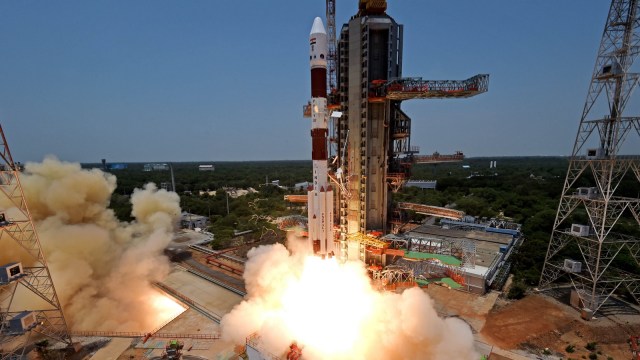Stay updated with the latest - Click here to follow us on Instagram
Solar mission: Aditya-L1 successfully enters final orbit; PM, President laud ‘extraordinary’ feat
Aditya-L1 was successfully inserted into the Larange Point 1, one of the five locations in the Earth-Sun system where the gravitational effects of the two roughly cancel each other out.
 ISRO's PSLV-C57 carrying Aditya-L1, India's maiden solar mission spacecraft, lifts off from the launch pad at Satish Dhawan Space Centre, in Sriharikota. (PTI/File)
ISRO's PSLV-C57 carrying Aditya-L1, India's maiden solar mission spacecraft, lifts off from the launch pad at Satish Dhawan Space Centre, in Sriharikota. (PTI/File)Aditya-L1, India’s first solar observatory, was successfully placed in the final orbit, its desired destination from where it will make observations of the Sun for the next five years.
Aditya-L1 was successfully inserted into the Larange Point 1, one of the five locations in the Earth-Sun system where the gravitational effects of the two roughly cancel each other out. It is a relatively stable point for a spacecraft to be parked, and make observations of the Sun.
Aditya-L1 was launched by the Indian Space Research Organisation (ISRO) on September 2, 2023 with the mission of observing, and helping us better understand the Sun.
Terming it as yet another landmark achievement, Prime Minister Narendra Modi , in a post on X, said, “India’s first solar observatory Aditya-L1 reaches it destination. It is a testament to the relentless dedication of our scientists in realising among the most complex and intricate space missions. I join the nation in applauding this extraordinary feat. We will continue to pursue new frontiers of science for the benefit of humanity.”
India creates yet another landmark. India’s first solar observatory Aditya-L1 reaches it’s destination. It is a testament to the relentless dedication of our scientists in realising among the most complex and intricate space missions. I join the nation in applauding this…
— Narendra Modi (@narendramodi) January 6, 2024
Speaking to reporters on the successful placing of Adiyta-L1 into its destination orbit, ISRO chairman S Somanath said, “What we have achieved today is the exact placement based on our measurement and very correct prediction of the velocity requirement. Right now, in our calculation, it is at the right place, but we are going to monitor for next few hours to see whether it is at the right place.”
VIDEO | “What we have achieved today is the exact placement based on our measurement and very correct prediction of the velocity requirement. Right now, in our calculation, it is at the right place, but we are going to monitor for next few hours to see whether it is at the right… pic.twitter.com/Aoa7mGVRMN
— Press Trust of India (@PTI_News) January 6, 2024
President Droupadi Murmu congratulated ISRO for the feat and said the mission will benefit the entire humanity. “Another grand feat accomplished by ISRO! As part of India’s maiden solar mission, Aditya L1, the observatory has been placed in the final orbit and reached its destination at Lagrange Point 1,” Murmu said in a post on ‘X’.
Murmu also said that the significant participation of women scientists in ISRO missions “takes women empowerment too onto a higher orbit”.
Another grand feat accomplished by ISRO! As part of India’s maiden solar mission, Aditya L1, the observatory has been placed in the final orbit and reached its destination at Lagrange Point 1. Congratulations to the entire Indian scientist community for the great achievement!…
— President of India (@rashtrapatibhvn) January 6, 2024
Union Home Minister Amit Shah hailed the country’s first solar mission craft Aditya-L1 reaching its destination, and said it was yet another milestone in Bharat’s journey through space.
“Another milestone in Bharat’s journey through space!! Our first solar observatory #AdityaL1 reaches its destination in the space. It is a momentous event in history that takes us closer to our civilizational goal of achieving human welfare through excellence in science and technology,” Amit Shah wrote on X.
Another milestone in Bharat’s journey through space!!
Our first solar observatory #AdityaL1 reaches its destination in the space. It is a momentous event in history that takes us closer to our civilizational goal of achieving human welfare through excellence in science and…
— Amit Shah (@AmitShah) January 6, 2024
In a post on X, Union minister Dr Jitendra Singh said, “From Moon walk to Sun Dance! What a glorious turn of year for Bharat! Under the visionary leadership of PM @narendramodi, yet another success story scripted by Team #ISRO. #AdityaL1 reaches its final orbit to discover the mysteries of Sun-Earth connection.”
From Moon walk to Sun Dance! What a glorious turn of year for Bharat!
Under the visionary leadership of PM @narendramodi, yet another success story scripted by Team #ISRO. #AdityaL1 reaches its final orbit to discover the mysteries of Sun-Earth connection.— Dr Jitendra Singh (@DrJitendraSingh) January 6, 2024
The latest achievement comes months after India’s Moon mission Chandrayaan-3 scripted history by successfully landing on the lunar surface on August 23 last year. With the Lander accomplishing a ‘soft landing’ on the Moon’s south pole, India became the only country to have ever done so.
Getting into the orbit around L1 is not the same as attaining an orbit around any other planetary body, and is being considered the most important challenge in this mission. The spacecraft will spend the rest of its mission life “orbiting around L1 in an irregularly-shaped orbit in a plane roughly perpendicular to the line joining the Earth and the Sun,” an ISRO scientist said.
Lagrange Points are relatively stable positions but not entirely free from pulls and pressures. However, these are still preferred locations for space missions intending to observe and study the Sun.







